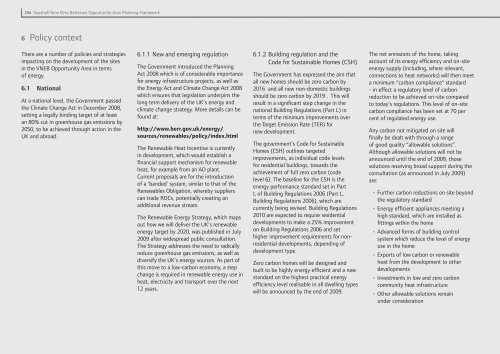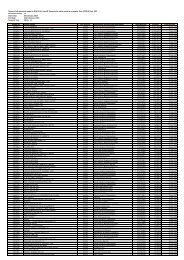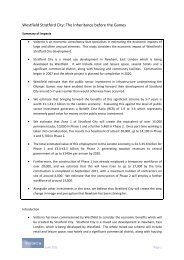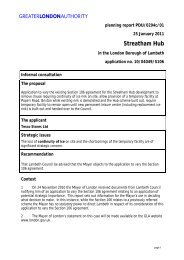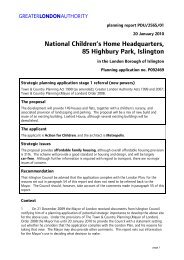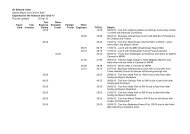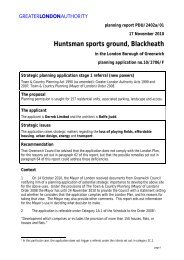Vauxhall Nine Elms Battersea Opportunity Area Planning Framework
Vauxhall Nine Elms Battersea Opportunity Area Planning Framework
Vauxhall Nine Elms Battersea Opportunity Area Planning Framework
You also want an ePaper? Increase the reach of your titles
YUMPU automatically turns print PDFs into web optimized ePapers that Google loves.
294 <strong>Vauxhall</strong> <strong>Nine</strong> <strong>Elms</strong> <strong>Battersea</strong> <strong>Opportunity</strong> <strong>Area</strong> <strong>Planning</strong> <strong>Framework</strong>6 Policy contextThere are a number of policies and strategiesimpacting on the development of the sitesin the VNEB <strong>Opportunity</strong> <strong>Area</strong> in termsof energy.6.1 NationalAt a national level, the Government passedthe Climate Change Act in December 2008,setting a legally binding target of at leastan 80% cut in greenhouse gas emissions by2050, to be achieved through action in theUK and abroad.6.1.1 New and emerging regulationThe Government introduced the <strong>Planning</strong>Act 2008 which is of considerable importancefor energy infrastructure projects, as well asthe Energy Act and Climate Change Act 2008which ensures that legislation underpins thelong term delivery of the UK’s energy andclimate change strategy. More details can befound at:http://www.berr.gov.uk/energy/sources/renewables/policy/index.htmlThe Renewable Heat Incentive is currentlyin development, which would establish afinancial support mechanism for renewableheat, for example from an AD plant.Current proposals are for the introductionof a ‘banded’ system, similar to that of theRenewables Obligation, whereby supplierscan trade ROCs, potentially creating anadditional revenue stream.The Renewable Energy Strategy, which mapsout how we will deliver the UK’s renewableenergy target by 2020, was published in July2009 after widespread public consultation.The Strategy addresses the need to radicallyreduce greenhouse gas emissions, as well asdiversify the UK’s energy sources. As part ofthis move to a low-carbon economy, a stepchange is required in renewable energy use inheat, electricity and transport over the next12 years.6.1.2 Building regulation and theCode for Sustainable Homes (CSH)The Government has expressed the aim thatall new homes should be zero carbon by2016 and all new non-domestic buildingsshould be zero carbon by 2019 . This willresult in a significant step change in thenational Building Regulations (Part L) interms of the minimum improvements overthe Target Emission Rate (TER) fornew development.The government’s Code for SustainableHomes (CSH) outlines targetedimprovements, as individual code levelsfor residential buildings, towards theachievement of full zero carbon (codelevel 6). The baseline for the CSH is theenergy performance standard set in PartL of Building Regulations 2006 (Part L,Building Regulations 2006), which arecurrently being revised. Building Regulations2010 are expected to require residentialdevelopments to make a 25% improvementon Building Regulations 2006 and sethigher improvement requirements for nonresidentialdevelopments, depending ofdevelopment type.Zero carbon homes will be designed andbuilt to be highly energy efficient and a newstandard on the highest practical energyefficiency level realisable in all dwelling typeswill be announced by the end of 2009.The net emissions of the home, takingaccount of its energy efficiency and on-siteenergy supply (including, where relevant,connections to heat networks) will then meeta minimum “carbon compliance” standard- in effect a regulatory level of carbonreduction to be achieved on-site comparedto today’s regulations. This level of on-sitecarbon compliance has been set at 70 percent of regulated energy use.Any carbon not mitigated on site willfinally be dealt with through a rangeof good quality “allowable solutions”.Although allowable solutions will not beannounced until the end of 2009, thosesolutions receiving broad support during theconsultation (as announced in July 2009)are:• Further carbon reductions on site beyondthe regulatory standard• Energy efficient appliances meeting ahigh standard, which are installed asfittings within the home• Advanced forms of building controlsystem which reduce the level of energyuse in the home• Exports of low carbon or renewableheat from the development to otherdevelopments• Investments in low and zero carboncommunity heat infrastructure• Other allowable solutions remainunder consideration


